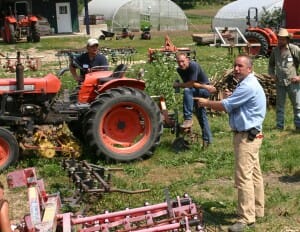Moving Stuff Around On The Market Farm: Rock Spring Farm’s Labor Saving And Profit Maximizing Devices With Chris Blanchard – PFI Field Day Report (Part 2 of 3)
Mechanical Transplanters
Johnny’s Hatfield transplanter – $80 Stand upright to plant transplants – a two-person job, one person holds the flat of plugs, one person handles the unit. This is really handy to fill in skips while the tractor turns around, and can save your back on smaller scale transplanting jobs.
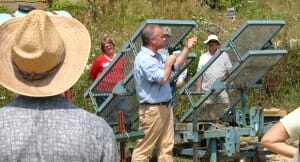
Waterwheel Transplanter – requires a tractor with a creeper gear to go ever so slowly. This design allows the users to sit near ground level and place transplants by hand into pre-made divots with water in the holes.
22C Transplanter $1,200 – this can plant up to 2,000 plants per hour
Model 1000 Transplanter $5,000 and up can plant up to 5-10,000 plants per hour
“If you know you want to grow to a bigger scale, buy a 22C or other transplanter but only get one row to save money. You can always add a row in the future,” says Chris.
Greenhouse and seedling transplant production
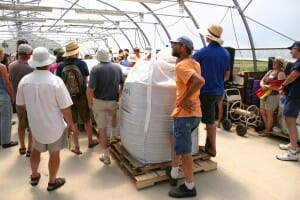 Purchase potting mix “by the sling” instead of by the bag to get a sizable quantity discount. While not required, a concrete pad in your greenhouse can help move it around with the help of a pallet jack.
Purchase potting mix “by the sling” instead of by the bag to get a sizable quantity discount. While not required, a concrete pad in your greenhouse can help move it around with the help of a pallet jack.
To prevent wasted labor time in the greenhouse, Chris uses a hanging trolley from greenhouse rafters that can fit 24 flats of transplants. One employee can move these all around the greenhouse with ease.
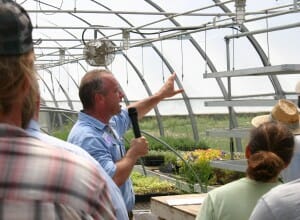 Greenhouse watering is essential; it takes skill, time, and precision. Chris invested in an overhead watering system that he manages to get regular water placed in each cell of all flats in the greenhouse. He saves time and worry with this automatic system that he manages. Emitters for irrigation and the systems can be purchased from various suppliers.
Greenhouse watering is essential; it takes skill, time, and precision. Chris invested in an overhead watering system that he manages to get regular water placed in each cell of all flats in the greenhouse. He saves time and worry with this automatic system that he manages. Emitters for irrigation and the systems can be purchased from various suppliers.
Deer fencing
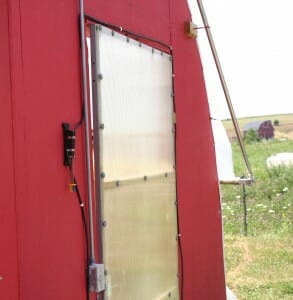
The fields at Rock Spring farm are located in a hilly wooded area surrounded by cropfields – ideal habitat for white tailed deer. To prevent costly deer browsing in his vegetable fields, Chris surrounds all fields with three strands of electric fence wire using moveable plastic posts and many copper ground wires spread around the fenced area. They monitor the energy of the fence daily and log this so they cat take action appropriately. To save time, and worry, Chris places his fence on/off lever in plain view on the exterior greenhouse wall, visible from his home living room.
Mechanical Cultivation
“No one really likes to hand weed, put your money into mechanical cultivation,” – Chris Blanchard
“High crop” or offset cultivating tractor – Chris uses an older L245H Kubota for his belly-mounted basket weeder cultivator. Purchased from, Buddingh Manufacturing Company in Wisconsin, the Buddingh Basket Weeder is ideal for cultivation in the early weed stages.
The “high crop” tractor is designed so the engine sits higher off the ground than a normal tractor. This is advantageous for organic vegetable farmers because it allows greater flexibility and options for cultivation when the plants are at larger growth stages. The tractor can pass over plants without damaging them, and can eliminate many weeds present.
Shovels and Sweeps – Shovels, and sweeps are used to eliminate weeds at larger growth stages. Acme Manufacturing in California is a great resource for clamps, and welded parts for cultivators. Chris recommends that farmers be sure to send them back if they are not perfectly square to your toolbar. “If you can, try to pull these off of old cultivators in fence rows to save yourself a bunch of money. One clamp can cost you $80, new,” warns Chris.
Flame weeding
Save labor by adding flames to your weed control practices. For carrots, Chris recommends farmers watch the growth stage. “If you can see the radicle extending downward, leaves will come up and turn over. That day is the right moment to flame weed, before the new shoots hook out of the ground.”
With a propane tank, walk at a fast clip, holding the flamer at an angle. “I bought a valve at Johnny’s Selected Seeds that keeps the flame lit so you don’t have to re-light it every time you stop. Simply squeeze the trigger and the lit propane flame blows out,” demonstrates Chris. “Remember, flame weeding only works on young, new weeds. For perennial grasses for example, the growth point is under the soil so flaming will just knock them back.”
This concludes part two of a three-part blog series on Chris Blanchard’s field day in mid-July, 2012. Special thanks to our individual field day sponsors, the Midwest Organic and Sustainable Education Service (MOSES), and the Iowa Organic Association (IOA). Funding provided by the Ceres Foundation

